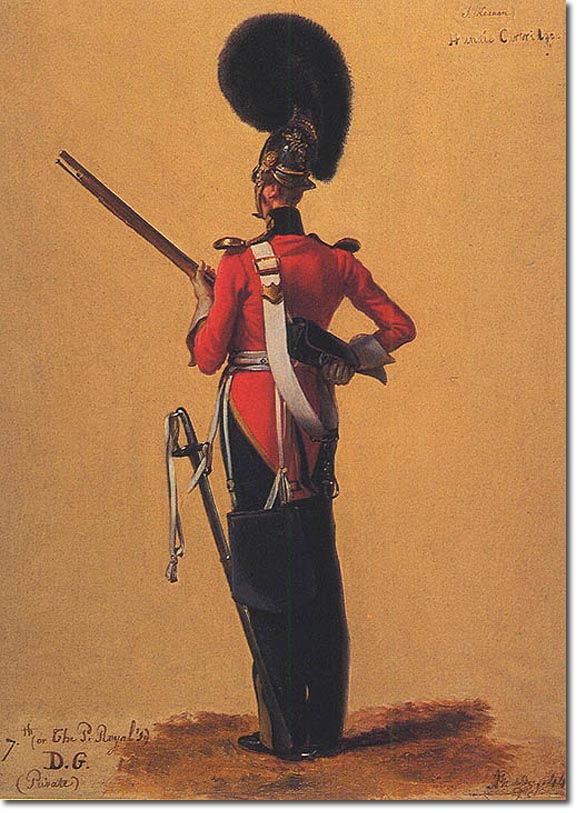|
|

 |
|
The wording at the top right of this painting says '(J.Kernan) Handle Cartridge' and in the bottom left corner the artist has written '7th (or the P. Royal's) D.G. (Private)'. This figure was modelled by Private John Kernan in 1832 as explained on the back of the painting. It also says that Kernan was 26 years old. According to Jenny Spencer-Smith's book Portraits for a King. John Kernan was an illiterate labourer born in 1806 in Rynough in the County of King's, now called Offaly or Ui Failghe, in Ireland. He was 20 when he joined the regiment at Birr in May 1825. This painting was executed in London in 1832. He developed a bad cold in Ireland some time in 1843 and when the regiment was stationed at Fort Beaufort in the Cape of Good Hope he became so ill that he had to be shipped home. He had breathing difficulties and ulcers on his legs, and was pronounced unfit for service. He died at the Royal Hospital Chelsea on 12th Jan 1869.
The pose is valuable to us because it demonstrates how cavalrymen of the period extracted ammunition from their pouch. The order 'Handle Cartridge' required the man to reach behind and take the cartridge without pulling the pouch round to the front or side of his body. The muzzle-loading carbine, like the sword was introduced in 1796. The uniform is viewed from the back so we cannot see the yellow lace on his sleeves or collar, but a surviving example of an actual dragoon guard's coatee has 4 simplified loops and tassels on each sleeve and two wide loops on each side of the collar so that the black velvet facings are not visible from the front. The tails of the coatee have black velvet turn-backs edged in yellow lace and have a small badge at the point where they meet. The sabretache, suspended from two white slings, must have been an annoying encumbrance, but it was discontinued for privates of heavy cavalry in 1834. The white waistbelt has a small white strap overlayed on the part that we can see. This is a puzzle that I am unable to explain. |
Armed Forces | Art and Culture | Articles | Biographies | Colonies | Discussion | Glossary | Home | Library | Links | Map Room | Sources and Media | Science and Technology | Search | Student Zone | Timelines | TV & Film | Wargames